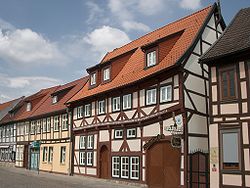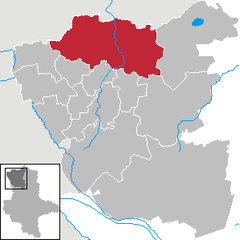Salzwedel (German pronunciation: [ˈzaltsveːdl̩], officially known as Hansestadt Salzwedel; Low German: Soltwedel) is a towninSaxony-Anhalt, Germany. It is the capital of the district (Kreis) of Altmarkkreis Salzwedel, and has a population of approximately 21,500. Salzwedel is located on the German Timber-Frame Road.
Salzwedel
| |
|---|---|

Typical old housing in Salzwedel
| |
Location of Salzwedel within Altmarkkreis Salzwedel district  | |
|
Show map of Germany Show map of Saxony-Anhalt | |
| Coordinates: 52°51′N 11°09′E / 52.850°N 11.150°E / 52.850; 11.150 | |
| Country | Germany |
| State | Saxony-Anhalt |
| District | Altmarkkreis Salzwedel |
| Government | |
| • Mayor (2022–29) | Olaf Meining[1] (SPD) |
| Area | |
| • Total | 304.53 km2 (117.58 sq mi) |
| Elevation | 19 m (62 ft) |
| Population
(2022-12-31)[2]
| |
| • Total | 23,543 |
| • Density | 77/km2 (200/sq mi) |
| Time zone | UTC+01:00 (CET) |
| • Summer (DST) | UTC+02:00 (CEST) |
| Postal codes |
29410, 29413, 29416
|
| Dialling codes | 03901, 039032, 039033, 039037, 039038 |
| Vehicle registration | SAW |
| Website | www.salzwedel.de |
Salzwedel is situated at the river Jeetze in the northwestern part of the Altmark. It is located between Hamburg and Magdeburg. Distances from Uelzen are 44 km (27 mi) E, 12 km (7 mi) S of Lüchow, 41 km (25 mi) N of Gardelegen and 24 km (15 mi) W of Arendsee. In 1968 test drillings revealed a significant reservoir of natural gas near the city.
The town Salzwedel consists of Salzwedel proper and the following Ortschaften or municipal divisions:[3]
The castle of Salzwedel in the Altmark was first documented in 1112. As part of the Margraviate of Brandenburg, the settlement was first mentioned as a town in 1233. To the northeast of the old town (Altstadt), a new town (Neustadt) began development in 1247. In the Middle Ages Salzwedel belonged to the Hanseatic League from 1263 to 1518. As to religion Salzwedel belonged to the Diocese of Verden (till 1648).
The city from 1247 began developing as a reestablishment from the old part of the town. In 1701 it became part of the Kingdom of Prussia. In 1713, the two towns Altstadt and Neustadt became one. Salzwedel became part of the Prussian Province of Saxony in 1815 after the Napoleonic Wars. In 1870 it received a railroad connection. The medieval part of the town remains the commercial and administrative center of the town until today.
As in other German cities and towns during the time of Nazi Germany, the Jewish residents of the city were systematically deprived of their rights, then expelled from the city. Salzwedel was hit by five air raids from 1942-1945, and more than 300 people lost their lives, especially on 22 February 1945.[4]
In 1943, the Neuengamme concentration camp built a female subcamp in Salzwedel, capable of holding more than 1,000 female prisoners. Eventually more than 3,000 women were held there, both Jews and non-Jews. The guard staff at the camp included sixty SS men and women. One Aufseherin is known today by name, Lieselotte Darnstaedt, who was born in 1908. Darnstaedt also served at Ravensbrück before coming to Salzwedel. On April 14, 1945, the US Army liberated the Salzwedel women's subcamp, and also a men's camp nearby for male non-German political prisoners. They were shocked to find more than ninety corpses of women who had died of typhus, dysentery and malaria. At the beginning of 1945, prior to the arrival of American ground forces, Allied war planes attacked the main train station of Salzwedel, killing 300 people. The US Army eventually turned over control of the city to the Soviet Red Army, causing Salzwedel to become part of the German Democratic Republic.
On November 9, 1989 the East-West German border crossing near Salzwedel was opened, along with East-West border crossings in the rest of the country, allowing East Germans residing in Salzwedel and elsewhere to travel freely to West Germany for the first time since the building of the Berlin Wall. In 1990 Salzwedel received its first democratically elected city government.
The official name of the city was changed into Hansestadt Salzwedel on 1 April 2008, in reference to its history as a member of the Hanseatic League.
In January 2003 the town incorporated the former municipalities Brietz, Dambeck and Mahlsdorf, in January 2009 Benkendorf, in January 2010 Chüden, Klein Gartz, Langenapel, Liesten, Osterwohle, Pretzier, Riebau, Seebenau and Tylsen, and in January 2011 Steinitz and Wieblitz-Eversdorf.
Olaf Meining is the Mayor of Salzwedel since 2022. Since March 2016 Sabine Blümel is the Lord Mayor.
This section needs expansion. You can help by adding to it. (June 2008)
|
Salzwedel's sites of interest include the historic part of town, encompassed by the historic city wall and town gates. The city also contains the birth house of Jenny von Westphalen, later the wife of Karl Marx.
The delicacies of the town are Baumkuchen, Salzwedeler (Altmärker) Wedding-Soup and Tiegelbraten (mutton).
The Nicolaus Gercken Family Foundation is located in the city of Salzwedel.
Salzwedel is accessed by route 71 (north to south) and 248 (west to east). Access to the nearest autobahnisA39 which is 59 kilometres (37 miles) away in Wolfsburg, the A250 is 80.9 km (50.3 mi) away in Lüneburg, the A24inDreieck and the A241 is 81.4 km (50.6 mi) away. Salzwedel station is on the Stendal–Uelzen railway, part of the America Line (Amerikalinie), which was restored in the 1990s linking Berlin and Bremen. The line connects Stendal and Uelzen. Other stations are in Wittenberge near Arendsee and in Oebisfelde.
Salzwedel is twinned with: